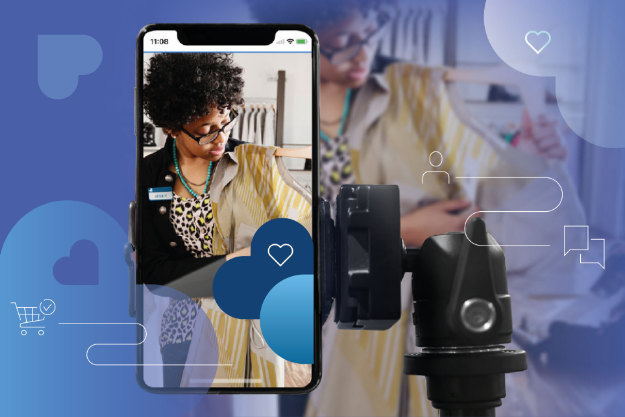Retailers today face a dilemma: their eCommerce sites have high online traffic, but low conversion rates. Brick-and-mortar stores face the opposite issue: low footfall, and high conversions.
Both eCommerce sites and in-person shopping have individual advantages. eCommerce sites have a much wider reach, without any geographical limitations or constraints on how many people they can serve at once. Physical retail, however, is far more interactive. Customers receive a personalized consultation, build a rapport with the store associate, and reap the benefits of a sensory experience.
But what if there was a way to combine the two for the ultimate selling experience?
Good news! Live shopping does just that. And it’s taking the world by storm.
What is live shopping?
Also known as livestream shopping, live video shopping, or live commerce, live shopping allows retailers to digitally broadcast their products via video and connect directly with online consumers.
Though audiences are unlimited, live shopping is far from impersonal. In fact, consumers can interact, engage, and ask questions via video or live chat channels. They can engage with their favorite influencers and add products directly to their basket from the stream.
Livestream shopping combines the huge traffic potential of websites with the significantly greater conversion rates associated with visiting a store. As a result, it has seen enormous growth since the COVID-19 pandemic. This growth has shown no signs of slowing down, with an industry that’s been estimated to be worth $600 billion in China, and $25 billion in the US, by 2023.
The undisputed market leader for live shopping is the Chinese platform Taobao, owned by eCommerce giant Alibaba. However, as live shopping gains global traction, other social platforms – like Facebook, Instagram, and TikTok – and eCommerce companies such as Amazon have also started to embrace live shopping.
Not convinced yet? Let’s dive into more key statistics below.
Stats show live shopping is booming worldwide
In 2020, people around the world adapted their day-to-day habits in response to the pandemic. Shopping was no exception. In the face of global store closures, many turned to online channels for a retail therapy fix. So, it should come as no surprise that livestream shopping has seen a dramatic boom over the past few years.
For example, one study found that livestream purchasing increased by an average of 76% worldwide from pre-pandemic times to 2021. Of the regions included in the study, Europe saw the highest growth during this period, with livestream shoppers growing by 86%, followed by The Middle East (76%) and North America (68%).
What countries and regions are seeing the largest demand for livestream shopping?
Statistics show that live shopping is most prevalent, by far, in East Asia, while China dominates in demand metrics.
China
After sitting at less than 120 billion yuan in 2018, the gross merchandise value of eCommerce live streaming in China increased by more than 18 times to 2.27 trillion yuan in 2021, and it's expected to top 4.9 trillion this year.
The United States
While U.S. eCommerce sales reached an estimated $17 billion in 2022, live online shopping is expected to increase its revenues by more than 3 times to $55 billion by 2026.
Europe
Sales made directly through a brand's website are not the only measure of how influential the website or eCommerce experience is on a brand’s overall bottom line. As of 2022, online sales accounted for 10-15% of EU retailers’ total sales, but according to shoppers, the online customer journey influenced up to 50% or more of both physical and online purchasing.
Who is livestream shopping?
While the term “live shopping” might conjure old-school, QVC-related associations, it’s key to note that these viewer demographics are very different from those of today’s live shopping audience.
QVC and teleshopping’s highest popularity is among viewers over age 55 while livestream shopping is a market growing most rapidly among Gen-Z and millennial consumers. According to McKinsey & Company, the product categories most often showcased are Apparel and Fashion (36% share), followed by Beauty products and Food (at roughly 7% each).
Gen Z consumers are leading the way in social commerce too. The Influencer Marketing Factory conducted a study comparing livestream shopping purchases amongst each age group, and Gen Z led with 47% of consumers having made a livestream purchase in both the US and UK. So utilizing these channels for live shopping has huge revenue potential for retailers and brands alike.

When do major livestream events take place?
Although livestream shopping events can happen any time and any place, brands have seen huge success holding live events on occasions like Black Friday and Singles’ Day.
Singles’ Day falls annually on November 11, and since its inception over 10 years ago, it has become the world’s biggest shopping holiday. Initially popularized by unmarried people in China, brands recognized the potential to target consumers and launched large-scale discount campaigns.
In 2022, 62 influencer and retailer-run livestream channels surpassed RMB 100 million ($14.2 million) in sales, and another 632 surpassed RMB 10 million ($1.4 million). These streams aren’t just everyday streams — they’re full-on events, with influencers, celebrities, and industry professionals taking the spotlight. It has also gone beyond China, and reached shoppers from the UK, US, and Australia. Although Alibaba (the leading Chinese eCommerce platform) did not disclose the exact numbers in 2022, they said sales were in line with last year’s, which saw roughly 540 billion yuan ($76.5 billion) in transactions for Alibaba alone over an 11-day period.
This year, Tmall’s partnership with Simon Properties and Shop Premium Outlets hosted a two-hour livestream from Woodbury Common that attracted nearly 1.4 million viewers to participate in live shopping for brands like Michael Kors, Coach, and Stuart Weitzman. Successful live streams were not only seen by big brands, but Singles’ Day this year also created an opportunity for rural livestreamers on Taobao Live (owned by Alibaba) to host more than 100,000 events featuring local products.
The benefits of livestream shopping are undeniable
As we have seen, the livestream shopping space is booming, and the rewards for retailers and consumers alike are huge.
For consumers
Livestream shopping removes the friction associated with physical shopping, but maintains important benefits like human interaction. It’s also a matter of ease since consumers can shop and connect from any location, at any time.
The days of spending valuable time traveling to physical stores, waiting in lines, and navigating through busy shopping centers can be eliminated with live streaming! Plus, it’s not just about shopping. Live streaming brings the entertainment and fun factor that consumers so often crave on social channels, offering an engaging and interactive customer experience for online shoppers.
For businesses
Livestream shopping can and should be an invaluable part of your brand’s digital strategies moving forward.
As the world emerges from the pandemic, social commerce continues to boom. In the US alone, the retail social commerce market is projected to reach over $56 billion in 2023, according to eMarketer. Given the rapidly growing market sizes, the opportunities are vast.
It’s more clear than ever that live shopping is not just a passing pandemic phase. It’s here to stay, and it's expected to continue growing worldwide according to Analysts. By 2026, live commerce sales could account for 20% of all eCommerce, and by 2024, the livestream ecommerce market is expected to reach 35 billion.
At Emplifi, our one-to-one and one-to-many live commerce solutions have helped power live shopping for some of the world’s top brands, resulting in increased conversions and average spend. Speak with an Emplifi expert today to see how we can help you take shopping to the next level.


































